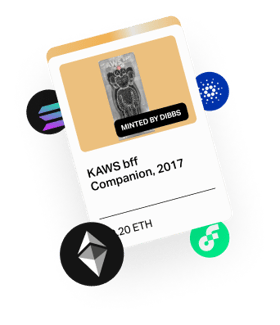How Brands can Preserve Creator Fees in the World of NFTs
Explore the significance of creator fees for brands and the challenge brands face when it comes to implementing them.

Digital collectibles are revolutionizing consumer experiences and ushering in a new era of brand-audience engagement. Forbes has even likened this cultural shift to the technological revolution in 1999.
However, offering immersive experiences is not the only lucrative aspect of collectibles; another major benefit of leveraging them is the ongoing revenue brands get from royalties or collector fees.
However, as major marketplaces are doing away with creator fees, brands are facing a major challenge.
In this article, we’ll do a deep dive into the importance of creator fees, the biggest challenges brands face in implementing them and, how they can circumvent this problem.
Subscribe to get our best content in your inbox
By clicking “Submit” you agree to Dibbs
Privacy Policy and
consent to Dibbs using your contact data for newsletter purposes.

The Importance of Creator Fees
For brands, implementing creator fees is a strategic move that offers the following benefits:
Ongoing Revenue
Royalties or creator fees serve as a continuous revenue stream for brands by ensuring they earn a predetermined percentage from every subsequent sale of their digital assets.
In other words, instead of earning just once from the initial sale, brands and creators benefit financially each time their work is resold. Over time, especially with high-demand assets or widely used products, these accumulated royalties result in significant ongoing income.
For example, Nike’s earnings from royalties ($92.99 million) are on par with the revenue generated from the primary sale of collectibles ($93.1 million).
Sustains Collaborative Partnerships
Brands often need to collaborate with artists, designers, and creatives to produce limited-edition merchandise and tap into a broader audience base. Creator fees ensure that these artists are fairly compensated every time their co-created digital asset is resold.
This continuous revenue fosters long-term partnerships and attracts top-tier creative talent when it comes to collaborations.
Ensures Value and Longevity of Digital Assets
Creator fees can indirectly ensure the sustained value and longevity of a brand's digital assets.
Let’s say a fashion brand releases a set of limited-edition digital collectibles. Each collectible is priced at $10,000 and every time it’s resold, the artist and the brand receive a combined royalty of 10%.
Over time, as the artist’s work gains prominence, the demand for their work skyrockets and spills over to digital assets. This results in an increase in the resale value and now, the collectibles that were initially bought for $10,000, are now being resold for $20,000.
For every resale at this price, the brand and the artist earn a combined $2,000 (10% of $20,000) without any additional effort. If the asset value appreciates, the embedded royalty fees ensure that the brand and the artist continue to earn revenue.
What are the Costs of Neglecting Creator Fees?
Since December 2021, a popular sneaker brand has generated $1.4B in secondary marketplaces across web2 and web3 marketplaces. Royalty fees account for half of this revenue.
However, due to the recent royalty fee circumvention, the brand has faced significant losses, with nearly $12M of revenue lost and an additional $1M+ from Web2 marketplaces like eBay and StockX.
Web2 marketplaces and traditional auction marketplaces aren’t any better as they don’t generate any revenue for the brand. Additionally, they introduce added friction and diminish the premium experience associated with the brand as the verification process might not be as stringent. This may lead to counterfeits entering the market and leading to loss of brand reputation and trust.
The Biggest Challenge of Preserving Creator Fees
One of the biggest challenges when it comes to preserving creator fees is preventing the resale of collectibles on different marketplaces with varying policies on creator fees.
Amidst the bear market, prominent marketplaces such as Magic Eden and LooksRare made the enforcement of royalties optional. Similarly, the Ethereum-based marketplace, X2Y2, unveiled its "Flexible Royalties" system, granting buyers the autonomy to determine their contribution amount towards creator royalties.
OpenSea, a leading figure in the NFT space, initially contemplated discontinuing royalties altogether. However, in a strategic pivot, they introduced the Operator Filter — an on-chain mechanism designed to enforce royalties. This tool effectively blacklisted collections from being traded on platforms that fail to honor royalty agreements.
However, they discontinued the tool and reduced their royalty fees from 2.5% to 0.5%. This is because platforms like Blur removed creator fees, found a way to circumvent the tool, and advised NFT project creators to block trades on OpenSea.
In short, the landscape of creator fees in the collectibles space is in a state of flux. And despite numerous attempts, a universally accepted solution to ensure consistent and fair creator compensation remains elusive.
How Dibbs is Helping Brands Earn Revenue From Creator Fees
Dibbs helps brands capture royalty fees on secondary marketplaces. We do this by editing the collectibles’ smart contracts so that they can’t be resold in Blur and other marketplaces.
Recently, we helped a popular strategy game launch redeemable collectibles and capture $12 million and $25 million in primary revenue and royalties respectively.
What’s more, we make it easy to tokenize brand assets, vault them, and distribute collectibles using secure and legally compliant strategies. If you want to learn more about how Dibbs can help you earn sustained royalties, schedule a demo with us today.

Evan Vandenberg
Evan Vandenberg is the Co-Founder and CEO at Dibbs. Evan has been working in the NFT space full-time since 2018 and collecting since 1995.

